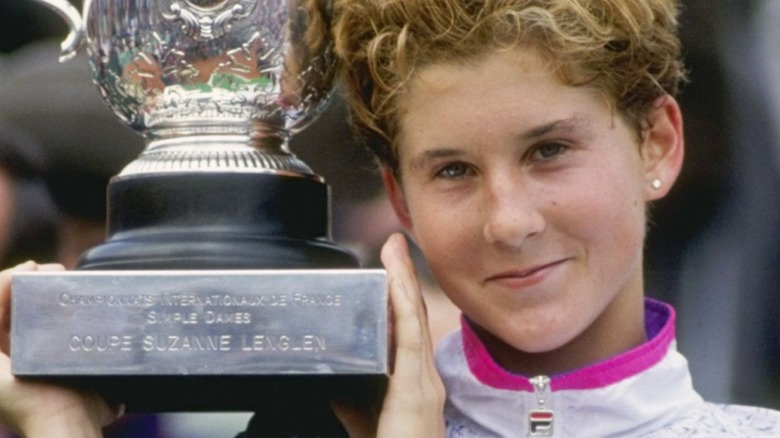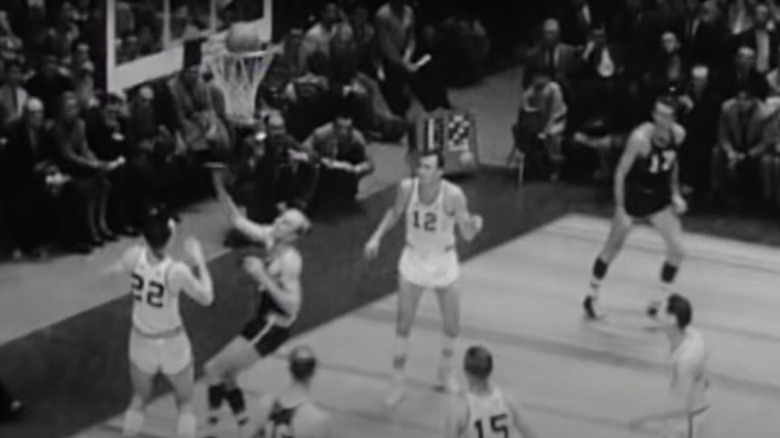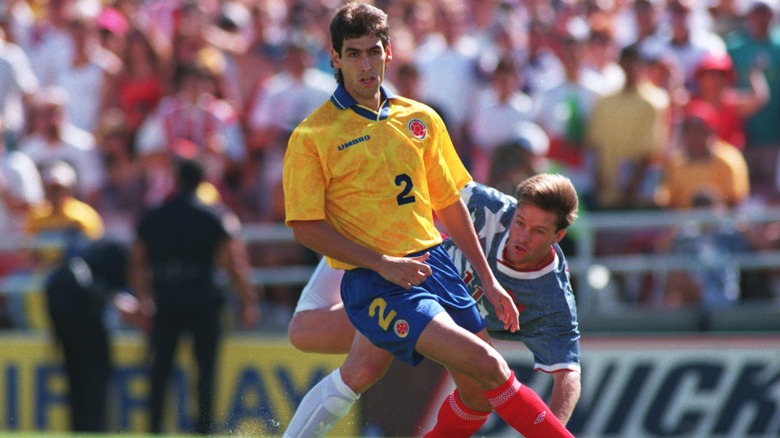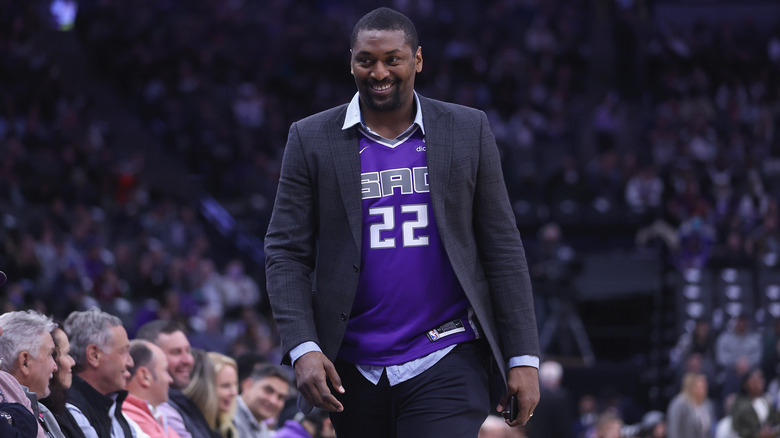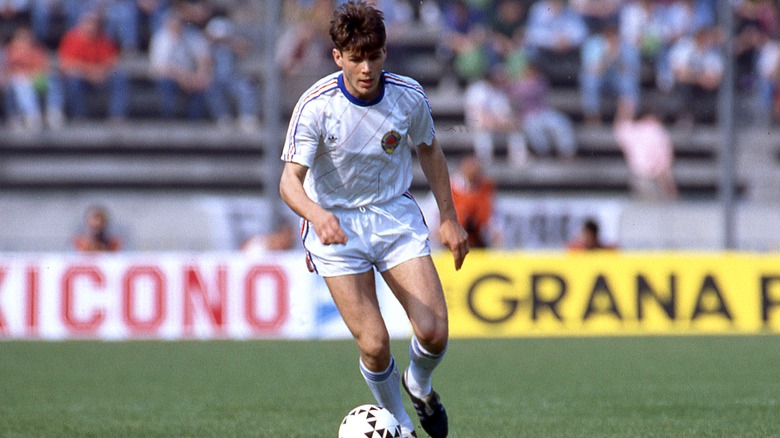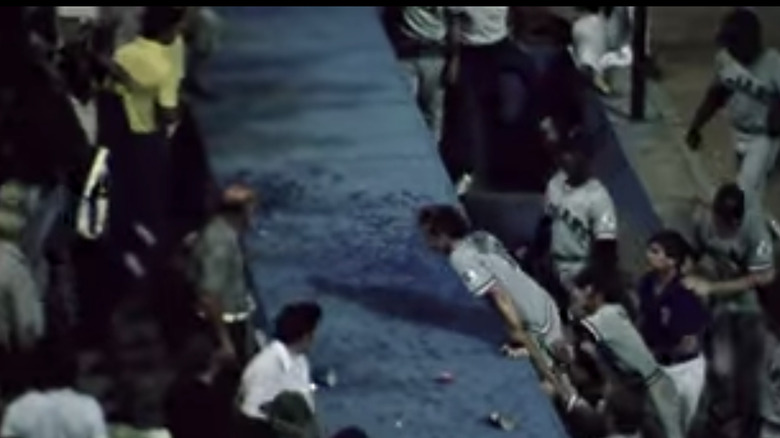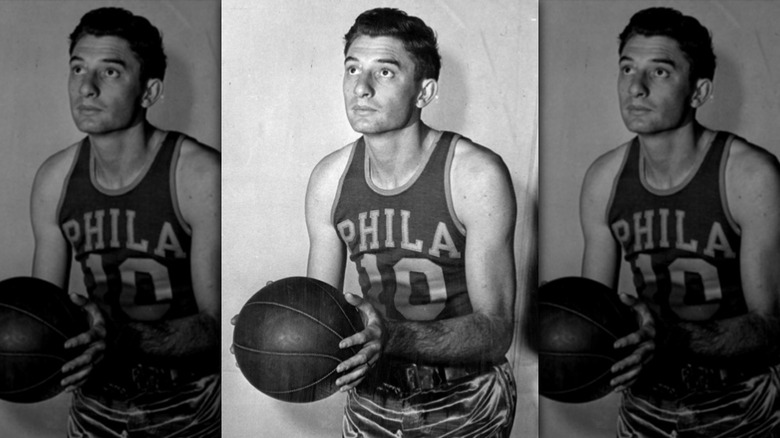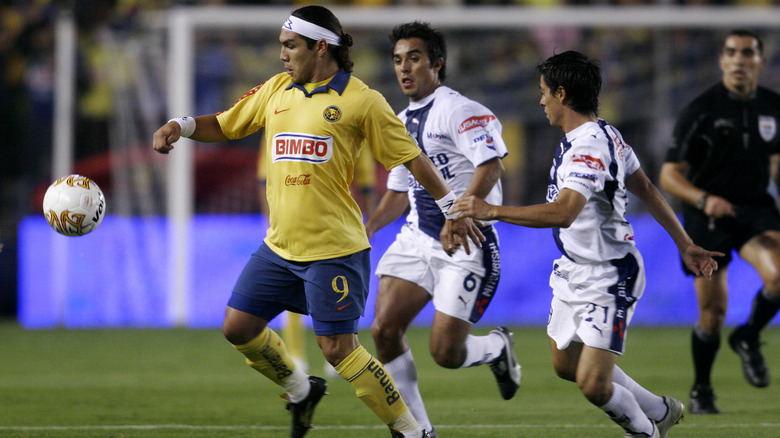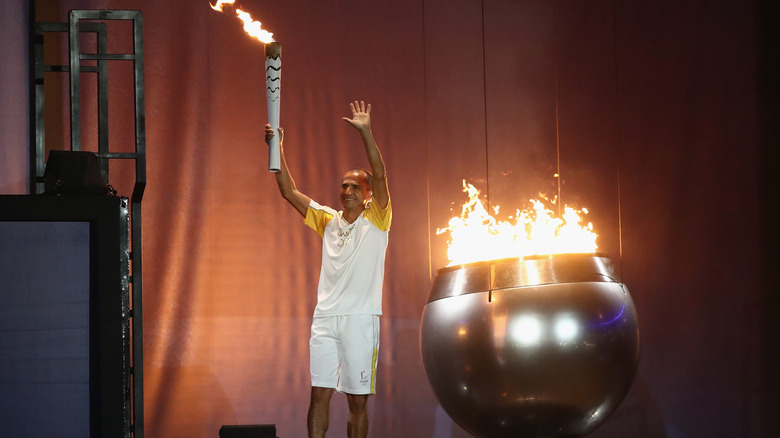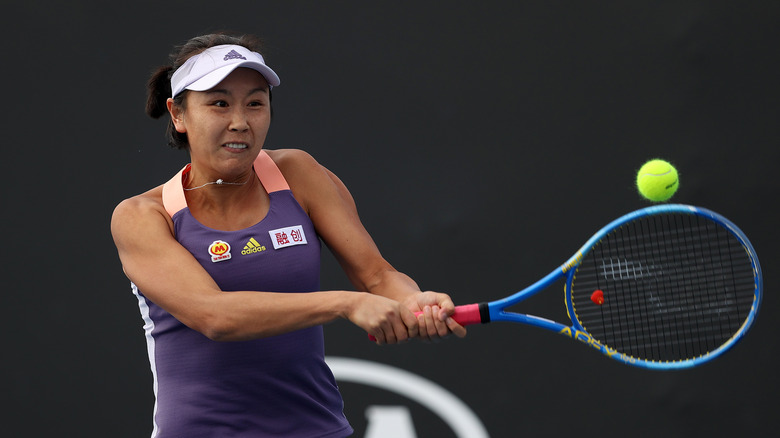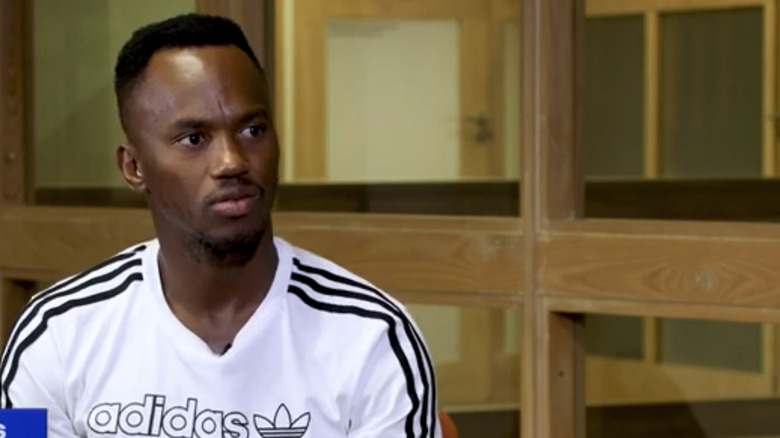Sports Stars Who've Been Violently Attacked By People
Being a professional athlete often brings some degree of fame, fortune, and of course, publicity. Make a mistake, and the press will be all over you. Make a really big mistake, and it might be the fans all over you — and not necessarily just on online forums.
Professional athletes always face some degree of danger. In the mid-20th century, before mass media and faces plastered everywhere, that danger was from organized crime — usually for those who got involved in illegal gambling. Today, it comes from rowdy fans, stalkers, or mentally unwell people whose motives seem impossible to comprehend. And of course, organized crime has only extended its tentacles into the sports world as the financial incentives to fix games and co-opt or intimidate players reap ever greater financial rewards.
At times, pro athletes have fought off their assailants and turned the tables — in one case igniting an independence war, if you believe the legend. In many other cases, there is little defense against an unexpected assault, especially if the assailant has a gun or is a high-ranking government official. Here are some of the sports stars who've been violently attacked by people.
Jack Molinas
Jack Molinas played for Columbia University and the Fort Wayne Pistons (today's Detroit Pistons). He was a true NBA talent, but he also had a major vice: He loved gambling and making a buck off betting on NBA games. He faced a suspension in 1954 for betting both for and against his own team. The big scandal, however, came in 1961, when Molinas was the center of a point-shaving scandal. He and his associates had been paying basketball players from over 22 different colleges to fix the scores of their games in order to allow Molinas and his co-conspirators to win bets. Molinas ended up serving five years, and the scandal revealed his deep connections with the criminal underworld that would later cost him his life.
In 1974, fresh off an arrest for trafficking in pornography, Molinas was standing outside in his backyard in Los Angeles, California, alongside a friend (possibly his girlfriend), per the 1975 edition of The New York Times. At 2.00 a.m., a sniper shot Molinas dead. Police believed it was likely linked to another one of Molinas' underworld activities, a fur business, and a life insurance policy he took out after the murder of a business associate.
Police had wanted to question Molinas over the murder of the associate, a man named Bernard Gusoff, but he had refused to talk, suggesting that he was in some way involved. In the end, his criminal activities probably caught up to him, although the murder remains unsolved to this day.
Andres Escobar
Colombia of the 1980s and early '90s was well-known for two things: coffee and cocaine, the latter of which was exported through Pablo Escobar's notoriously violent Medellin Cartel. Despite the cartel wars, however, the national soccer team gave the populace something to smile about when "Los Cafeteros" qualified for the 1994 FIFA World Cup in the United States.
Despite the wealth of talent, Colombia flopped at USA '94, being eliminated after losses to Romania and the United States. To make matters worse, the first goal conceded against the U.S. was an own goal from captain Andres Escobar (no relation to Pablo Escobar).
Now, according to Andres' teammate Freddy Rincon, who gave an interview about the event to Sabotage Times in 2011, the owners of Colombia's soccer teams were "not guys you wanted to annoy." Many were old cartel bosses and had money placed on Colombia's performance. Being from the cartel stronghold of Medellin, people soon began to fear for Andres' safety following his own goal, for good reason. After the tournament, Andres was at a Medellin bar called El Indio. Two gangsters accosted him about his own goal. Stories differ about what exactly happened, but in the end, the two men shot Andres six times, killing him. Rumor has it that the killers yelled "gol" or "autogol" with each shot, in reference to Spanish-language commentators who would shout that whenever a goal was scored.
Ron Artest
Ron Artest is best known as the guy who ignited the infamous 2004 fan brawl in Detroit. The game between the Indiana Pacers and Detroit Pistons was going well for the visitors. As the clock ran down and the Pistons were behind 97-82, a frustrated Artest let his temper get the better of him when he fouled the Pistons' Ben Wallace from behind as the latter was going for a layup. Wallace and his teammates were naturally not happy and a minor brawl erupted between the two teams.
Now matters might have ended there had not fans gotten involved. As the ESPN announcers noted at the time, Pistons fans, who were frustrated with their players' performance, had been heckling and abusing them for some time. One of them threw a beverage at Artest, which fortunately did not injure him. While the NBA would have expected him to show restraint, Artest had enough. He made his way into the stands and attacked a different, completely innocent fan. This ignited a massive brawl as more fans joined in, escalating into what is today known as the "Malice at the Palace."
Artest paid dearly for his actions: He was hit with a full season suspension per ESPN, losing nearly his entire $5 million salary.
Zvonimir Boban
Zvonimir Boban was captain of the Croatian team Dinamo Zagreb, which in 1990, played in the Yugoslav First Division. But that year, he made a name for himself for refusing to let police beat him up without a response. See, in 1990, Yugoslavia was coming apart at the seams, and it showed in the sports world. In May, the calendar had a volatile fixture pitting Serbian powerhouse Red Star Belgrade against Dinamo Zagreb and the Maksimir Stadium in the Croatian capital. With nationalistic tensions reaching a boiling point, a massive riot broke out before the game started, per Trans World Sport.
During the chaos, most of the players went back to the locker rooms. Boban, however, stayed on the pitch and confronted the mostly-Serbian police who were beating a Dinamo fan. As video of an oft-omitted angle from the riot shows, the police attacked him with batons as well, and one of them seemed to have landed a hit on Boban's face.
Boban managed to get away from the officers and, had he disengaged, that might have been the end of it. Instead, however, he went back and kneed officer Refik Ahmetović (who was actually a Bosnian Muslim) in the chin. For this, Boban got himself a six-month suspension from the Yugoslav FA. More significantly, however, he is known in Dinamo folklore as the player who started the Croatian War of Independence, a sentiment he fully agrees with today.
Tom Hilgendorf
The former Cleveland Indians player Tom Hilgendorf is best known for his role in the famous Ten-Cent Beer Night Riot of 1974. That year, the troubled Indians hosted the Texas Rangers. In a bid to raise attendance, management decided to sell ten-cent beer to anyone who would come – and come they did. The stadium was filled that night with tons of teenagers and young adults who weren't exactly stadium regulars. Many were looking for free booze and drugs. Many of them were also looking for trouble, as evidenced by the number of weapons and fireworks brought into the stadium that night.
It suffices to say that after a series of streaker incidents, a riot broke out during the 9th inning. Fans attacked the entire Texas Rangers squad with chains, bats, and fireworks. In a display of solidarity, the Indians players closed ranks with their opponents and protected them, requiring them to fight their own fans. Tom Hilgendorf was on the front lines, receiving a blow to the head after a fan threw a steel folding chair at him.
Miraculously, Hilgendorf and Texas Rangers player Joe Burroughs, who had been at the center of the riot, were the only players injured, per Cleveland News. Burroughs' injury was to his thumb, so nothing life-threatening either. Cleveland, which had been winning the game up to that point, forfeited. Despite the hit, Hilgenford came back the next night for two innings in a 9-3 victory over the Rangers, notching three strikeouts. Not bad after the previous night's excitement.
Joe Fulks
Today, the jumpshot is the standard shot in basketball. But interestingly, it did not become common in the pros until Joe Fulks began smashing records with it in the 1940s. Before that, the norm had been a two-handed shot with both feet on the ground. He eventually became a star with the Philadelphia Warriors in the old Basketball Association of America (now the NBA).
According to Vice, Fulks abused alcohol, although the term "alcoholic" had not been officially defined in the 1950s. But it might have cost him his life. In 1976, he visited his girlfriend Roberta Bannister. She had a 22-year-old son named Greg, who hated Fulks out of a sense of paternal loyalty. Greg and Fulks got into an argument, which was exacerbated by both men's heavy drinking of vodka. There were also guns in the house, and guns and alcohol don't mix particularly well. The story goes that Fulks had an issue with a pistol Greg's wife Sharon owned. Fulks demanded Greg leave. In response, Greg retrieved a shotgun and shot Fulks point-blank in the carotid artery, leaving him to bleed to death.
Fulk's death and funeral were just a footnote – one story on page seven of the Associated Press. None of his former teammates attended his funeral, and he was quickly forgotten except among basketball diehards. That is, until his role in popularizing the jumpshot came to light in 1999. Greg Bannister served two years in prison for reckless homicide.
If you or anyone you know needs help with addiction issues, help is available. Visit the Substance Abuse and Mental Health Services Administration website or contact SAMHSA's National Helpline at 1-800-662-HELP (4357).
Kim Glass
Kim Glass made her name in volleyball circles as part of the silver medal-winning 2008 USA Olympic squad. In fact, she was so good that her alma mater, the University of Arizona, retired her number back in 2011. After retiring from volleyball, Glass settled in her native Los Angeles and became a model. In July 2022, an unhoused man randomly attacked her while she was meeting a friend for lunch in the city's downtown.
What happened, according to Glass' own testimony, was that the man ran up to her from across the street and threw a metal object at her face, giving her a black eye and a cut above her nose. The object, which was likely a pipe, also fractured her eye socket in several places. According to video footage obtained by TMZ, the attack left several small puddles of blood on the ground.
In the end, Glass was okay. She later shared a video on her Instagram (via TMZ), noting that she had required 40 stitches to her face. Her attacker, meanwhile, was held down by a witness who got the police involved. Police later identified the attacker as Semeon Tesfamariam, who was charged with felony assault.
Salvador Cabanas
In 2010, Paraguayan international Salvador Cabanas was in peak form, playing a central role in the offense of Mexico's star-studded Club America. His most recent achievement had been helping his country qualify for the 2010 FIFA World Cup in South Africa, which earned him the attention of the English club Sunderland. But there would be no European or World Cup dream for Cabanas, whose career abruptly ended with a bullet.
After a 2-0 loss to Monarcas Morelia, Cabanas, who had been having knee issues, decided to take some time off with family. One fateful night, he went to a high-end Mexico City establishment called Bar Bar, frequented not only by celebrities but by members of Mexican organized crime, including narcos. One of these, a man named Jose Juan Balderas told Cabanas that he was stealing money from Mexico by sending it back to Paraguay and shot him in the head, per the BBC.
The bullet, which was never removed, impaired Cabanas' vision and memory, prematurely ending his career. He was forced to move back in with his parents and take a job as a delivery driver – a considerable downgrade from the glamorous job of being a Mexican soccer star. In 2014, he attempted to make a comeback in the lower divisions of his native Paraguay and Brazil, but it proved to be too much. Since then, he has been absent from the soccer world, despite a rumor in Mexico's El Diario Popular that he would return to Club America as a coach.
Vanderlei de Lima
One of the more bizarre incidents of Olympic history involves a former Catholic priest, and two marathon runners – one each from Brazil and Italy. Brazilian marathoner Vanderlei de Lima was winning the 2004 Athens Olympic marathon. Suddenly, defrocked Irish priest Neil Horan jumped out of the crowd and shoved de Lima into the spectators, per The New York Times. The shove, which came at mile 22, threw de Lima's rhythm off and allowed Italy's Stefano Baldini to win the race, leaving the Brazilian with a third-place finish.
Horan had apocalyptic, heterodox beliefs, and a habit of interrupting sporting events, most notably jumping into the middle of the track during the British Grand Prix while cars were racing on it in 2003. But he claimed that he had no intention of pulling any stunts in Athens. So why did Horan shove de Lima? He said it was "destiny," adding that the Brazilian would have been "nowhere near the star if not for [him]." For his trouble, Horan ended up in jail and was later fined.
As of the 2016 NYT interview, Horan said he still held a grudge against de Lima because the Brazilian had never acknowledged his letters of apology. The former priest maintains that had he not shoved de Lima, the Brazilian would have faded into obscurity rather than lighting the Olympic flame at the 2016 Rio games. De Lima did not comment, but one can guess that he is still none too happy about the lost gold medal. Baldini probably didn't mind, though.
Peng Shuai
Peng Shuai is one of China's most recognizable tennis stars. She made waves as the No.1 ranked doubles player in the world, winning the doubles both at Wimbledon and the French Open in 2013. A decade later, however, she would be better known for her #MeToo allegation against Chinese Vice Premier Gaoli Zhang – one of the most powerful officials in the Chinese Communist Party (CCP), and with whom she had an on-again-off-again relationship. She claimed in a post on the Chinese social network Weibo that Zhang sexually assaulted her in 2018, per NPR.
The allegations of criminal assault implicated the CCP and proved embarrassing for the state, so Beijing quickly put a damper on the story, per NPR, regardless of the veracity of the allegations. In 2022, Shuai gave a staged interview with the French magazine L'Equipe, arranged by the CCP, in which she retracted all allegations against Zhang.
Shuai then mostly receded from public view outside a few CCP-approved appearances in state media, resulting in concerns about her safety, freedom to speak and move about China, and whether the CCP took control of her social media. If true, she would be among the highest-profile victims of China's massive surveillance state.
If you or anyone you know has been a victim of sexual assault, help is available. Visit the Rape, Abuse & Incest National Network website or contact RAINN's National Helpline at 1-800-656-HOPE (4673).
Monica Seles
Yugoslav Hungarian tennis player Monica Seles was on top of the world in 1993. At just 19 years old, she had dethroned German Steffi Graf and won eight of 11 grand slam events.
There seemed, however, to be some resentment of her success among Graf's German fans. For whatever reason, an unemployed German lathe operator named Gunter Parche took Seles' ascent personally. So when she went to Hamburg to play against Bulgarian Magdalena Maleeva, Parche managed to get courtside and stab her in the back. Seles received a knife wound to her spine and shoulder blade, barely avoiding paralysis in part because she was hunched over when the knife entered her back. She never recovered her pole position in the tennis world while Stefanie Graf got it back – just as Parche had intended.
To add insult to injury, Seles never saw justice for the attack. She spent two years in physical therapy and only made it back to tennis in 1995. But she was never the same. Parche, meanwhile, was given a two-year suspended sentence because he had only intended to injure Seles, not kill her. German courts justified their decision based on Parche's mental instability, according to The New York Times, while the tennis world roundly criticized the verdict, noting that Seles could have died.
Mhlengi Gwala
Having competed in various triathlons at the elite level since 2015, South African triathlete Mhlengi Gwala's life changed radically in 2018 when he survived a vicious attack while training at home in South Africa. Gwala was out training one morning when three men ambushed him, according to the BBC. They dragged him behind some bushes at gunpoint and instead of just robbing him, proceeded to try and amputate his leg with a chainsaw. From Gwala's own testimony, it seems they tried to cut it above the knee, leaving only 20% of his leg intact.
Gwala told the BBC that doctors attempted everything to save his leg; he underwent five hospital admissions and several surgeries to reattach it. But on the sixth attempt, he got an infection and had to have the limb amputated and replaced with a prosthetic. Thus, his days of competing in the regular elite triathlons were over. No one was ever arrested for the assault and the case remains cold.
However, Gwala made the best of his situation. He won the 2022 African Triathlon Championships in Agadir, Morocco, and continued working toward qualifying for future paralympic events.
